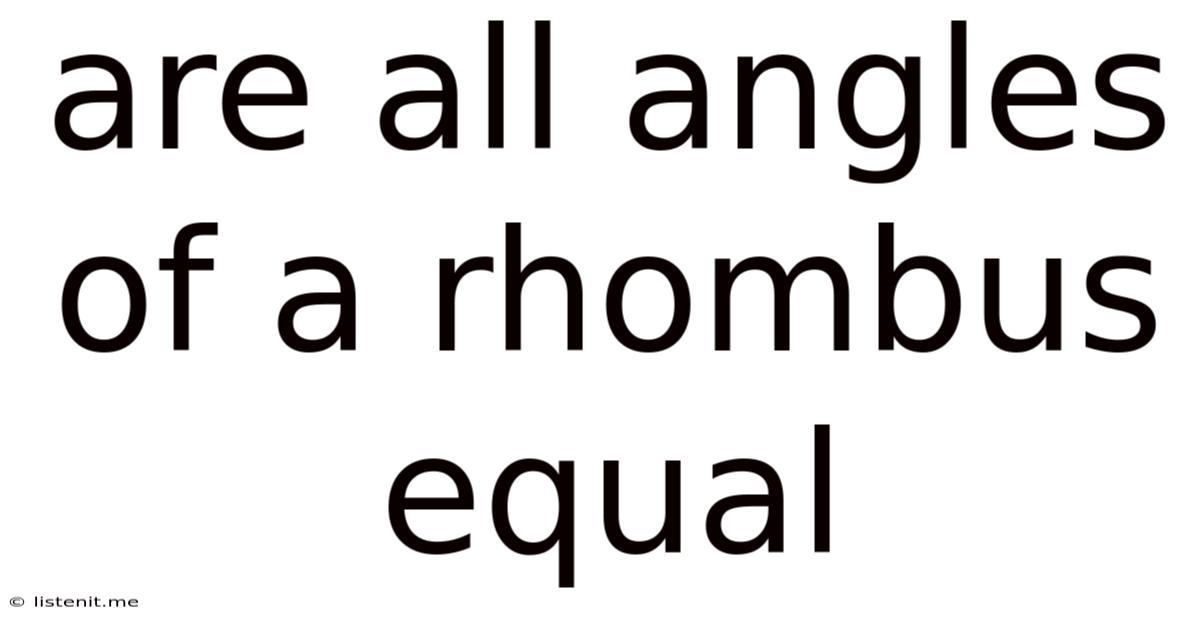Are All Angles Of A Rhombus Equal
listenit
May 12, 2025 · 4 min read

Table of Contents
Are All Angles of a Rhombus Equal? Exploring the Properties of Rhombuses
The question, "Are all angles of a rhombus equal?" leads us into a fascinating exploration of geometric shapes and their properties. The short answer is no, not all angles of a rhombus are equal. However, understanding why requires a deeper dive into the definition and characteristics of a rhombus. This article will comprehensively examine the properties of rhombuses, differentiating them from squares and other quadrilaterals, and clarifying the specific conditions under which a rhombus might possess equal angles.
Understanding the Rhombus: A Definition
A rhombus is a quadrilateral (a four-sided polygon) with all four sides of equal length. This is its defining characteristic. Think of it as a "squashed" square or a diamond shape. This equal-sided nature immediately distinguishes it from other quadrilaterals like rectangles, parallelograms, and trapezoids.
Key Properties of a Rhombus:
- Equal Sides: All four sides are congruent (equal in length). This is the fundamental property.
- Opposite Angles are Equal: While all angles aren't necessarily equal, the opposite angles within a rhombus are always congruent. This means that angle A is equal to angle C, and angle B is equal to angle D.
- Opposite Sides are Parallel: Similar to parallelograms, the opposite sides of a rhombus are parallel to each other. This parallelism contributes to many of the rhombus's other properties.
- Consecutive Angles are Supplementary: Any two angles that share a side (consecutive angles) add up to 180 degrees. This is a direct result of the parallel sides and the properties of transversal lines.
- Diagonals Bisect Each Other: The diagonals of a rhombus (the lines connecting opposite corners) intersect at a right angle, and each diagonal bisects (cuts in half) the other. This creates four congruent right-angled triangles within the rhombus.
Differentiating Rhombuses from Squares
This is where the confusion about angles often arises. A square is a special case of a rhombus. A square fulfills all the requirements of a rhombus (equal sides), plus it has an additional property: all its angles are equal (90 degrees each).
Therefore, while all squares are rhombuses, not all rhombuses are squares. The key difference lies in the angles. A rhombus can have angles of varying measures, as long as the opposite angles are equal and consecutive angles are supplementary.
When a Rhombus Has Equal Angles: The Square
The only time a rhombus possesses all equal angles is when it's a square. In this scenario, each angle measures 90 degrees. This transition from a general rhombus to a square highlights the hierarchical relationship between these geometric shapes.
Let's illustrate with a simple example:
Imagine a rhombus with angles:
- Angle A = 60 degrees
- Angle B = 120 degrees
- Angle C = 60 degrees
- Angle D = 120 degrees
Notice that opposite angles are equal (A=C and B=D), and consecutive angles are supplementary (A+B = 180, B+C = 180, C+D = 180, D+A = 180). This is a typical rhombus, but not a square because the angles are not all equal.
Exploring Rhombus Angles Through Calculations
Let's explore the angle relationships mathematically. Since consecutive angles are supplementary, if we know one angle (let's call it 'x'), we can calculate the others:
- Angle A = x
- Angle B = 180 - x
- Angle C = x
- Angle D = 180 - x
Only when x = 90 degrees (and consequently, 180-x = 90 degrees) do all angles become equal, resulting in a square.
The Importance of Understanding Rhombus Properties
Understanding the distinct properties of a rhombus, particularly its angle relationships, is crucial in various fields:
- Mathematics: It forms a foundation for more advanced geometric concepts and proofs.
- Engineering: Rhombus-shaped structures are used in various engineering applications, taking advantage of their strength and stability.
- Computer Graphics: Understanding rhombuses is essential in computer graphics and animation for creating and manipulating shapes.
- Physics: The properties of rhombuses are relevant in understanding forces and vectors.
Real-World Examples of Rhombuses
Rhombuses are far more common than you might initially think. Look around you, and you might spot them in:
- Crystals: Many crystals exhibit rhombic structures.
- Tiles: Floor and wall tiles often incorporate rhombus shapes in their designs.
- Artwork: Rhombuses frequently appear in artistic creations, adding visual interest and dynamic patterns.
- Architecture: Some architectural designs utilize rhombic structures for aesthetic or structural purposes.
Conclusion: A Rhombus's Angle Identity
In conclusion, the answer to the question, "Are all angles of a rhombus equal?" is definitively no. While a rhombus possesses equal sides, its angles are only equal when it's a special case – a square. Understanding the differences and the specific properties of rhombuses is key to grasping fundamental geometric principles and appreciating their presence in various aspects of the world around us. This comprehensive exploration hopefully clarified the distinctions and provided a deeper insight into the fascinating world of geometry. Remember, the defining characteristic is equal sides, while equal angles are a characteristic only of the subset of rhombuses known as squares.
Latest Posts
Latest Posts
-
What Is 1 3 As A Whole Number
May 12, 2025
-
Is Oxygen A Waste Product Of Photosynthesis
May 12, 2025
-
What Percentage Of 40 Is 16
May 12, 2025
-
A Possible Explanation For A Set Of Observations
May 12, 2025
-
1 3 8 Inch To Decimal
May 12, 2025
Related Post
Thank you for visiting our website which covers about Are All Angles Of A Rhombus Equal . We hope the information provided has been useful to you. Feel free to contact us if you have any questions or need further assistance. See you next time and don't miss to bookmark.